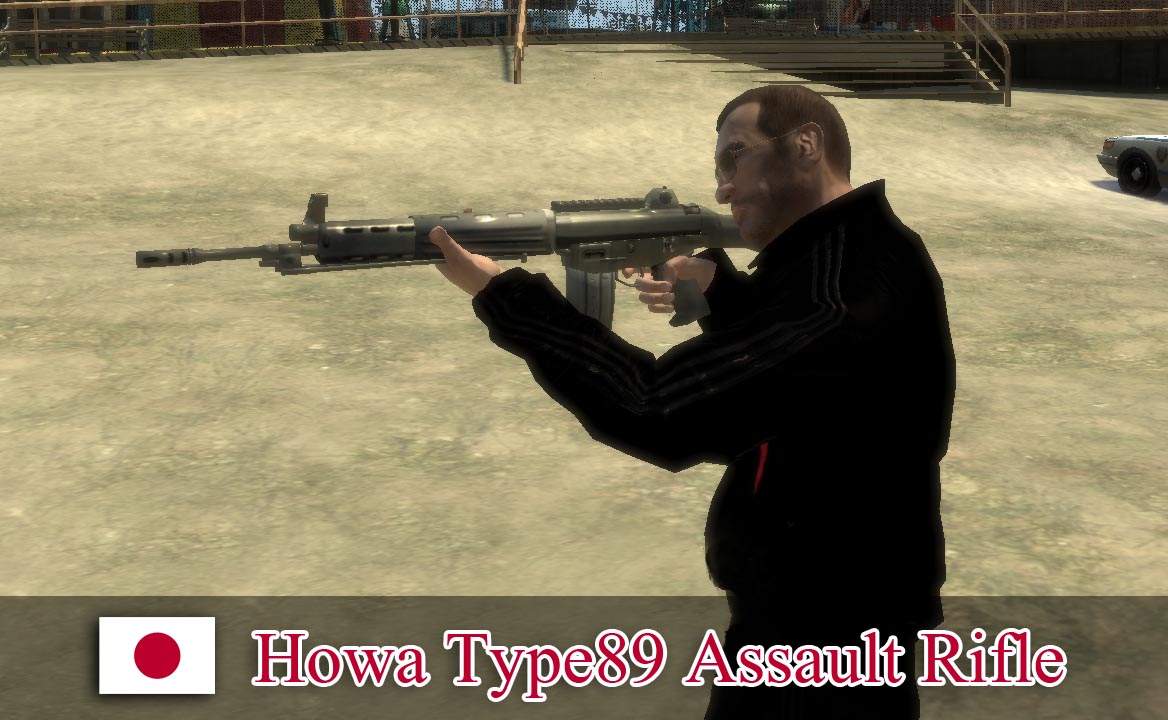Howa Type 89 Assault Rifle - In the late 1980s, the Japanese Ground Self-Defense Force decided to replace their old 7.62 Howa Type 64 assault rifles with 51 millimeters. The JGSDF selected a lighter, more modern assault rifle, the Howa Type 89, in 1989.
It's a solid weapon, but with some odd features. However, the biggest problem with it is that there are not enough copies of it.
Howa Type 89 Assault Rifle

The company Howa Machinery Company, Ltd. had previously produced the Type 64 and also made a licensed copy of the Armalite AR-18. The Japan Defense Agency and Howa developed a number of prototypes in the 1980s, with the JGSDF eventually adopting the HR-16 prototype as the Type 89.
Japan Unveils Next Generation Assault Rifle
The new rifle represents a major improvement in ergonomics over the Type 64. It houses the standard NATO cartridge of 5.56 by 45 millimeters and is fed from a 20- or 30-round magazine. The rifle has a short-stroke gas piston system with a rotating bolt derived from the AR-18.
The Type 89 is significantly more manageable than the previous Type 64. It weighs 7.7 pounds and measures 36.1 inches from muzzle to butt. The fire selector has four positions in an unconventional order: safe, automatic, three-round burst, and semi-automatic.
Another unusual feature of the gun's fire control group is the inclusion of an independent three-wheel burst mechanism.
Improves gun handling. The rifle has a stamped receiver combined with forged aluminum parts and polymer furniture.
Japan Ground Self Defense Force Soldiers Aim Their Howa Type 89 Assault Rifle During Military Operations In Urban Terrain Training As Apart Of Exercise Iron Fist, Aboard Marine Corps Base Camp Pendleton,
Like the Type 64, the Type 89 comes with a built-in bipod. The Type 89-F variant has a shorter overall length and a side-folding variable length stock.
The Type 89 can be equipped with a canvas cartridge catcher and a bayonet. Can fire the Type 06 Rifle Grenade without additional accessories. It is also possible, with an adapter, to fit the grenade launcher under the M203 40mm barrel.
The top of the gun has a mounting point for rails to attach the optics. The JGSDF issues a few unmagnified red dot optics and personnel can purchase their own optics if desired.

The JGSDF is currently upgrading the Type 89 with a quad-rail system as part of Japan's Advanced Combat Infantry Equipment System program.
Tokyo Marui Howa Type 89 Gbbr
Made every effort to install an ambidextrous selector switch or to upgrade the magazine properly to make magazine changes easier.
Howa has produced around 100,000 Type 89s, not enough to arm the entire JGSDF. Thus the older Type 64 remains in service with second-line units.
From drones to AKs, high tech to low politics, explore how and why we fight over, over and under an angry world. The Howa Type 89 Assault Rifle (89式小銃, hachi-kyū-shiki-shōjū), known as the Type 89 5.56mm Rifle (89式5.56mm小銃, hachi-kyū-shiki-go-t-go-roku-rifle ) -shōjū),
The Type 89 was introduced to replace the Howa Type 64 assault rifle in frontline units, entering service in 1989. It has been Japan's primary service rifle since that year. A limited number of the Type 89's replacement, the Howa Type 20, was purchased in 2020.
Problem: Japan's Type 89 Rifle Isn't Ready For A War
Like most other nations, Japan began the Cold War with a battle rifle: the 7.62 × 51 mm NATO Howa Type 64. However, over time, especially during the Vietnam War, the shortcomings of the battle rifle were overcome, and eventually, assault rifles began to be replaced by assault rifles, which fired intermediate rounds, although they had a weaker effective range compared to assault rifles. The 5.56 × 45 mm (SS109) cartridge, first used in the M16 rifle, eventually became the standard ammunition type for all NATO members' assault rifles. In addition, the Defse Agcy began to develop its next-generation assault rifle to replace the 7.62 × 51mm Type 64 assault rifle after its 25 years of service.
Development was primarily handled by Howa, as it was already licensed to produce the AR-180 version of the Armalite AR-18 rifle for commercial purposes, and some of the inner workings of the Type 89 are the same as the AR-18, the type. 89 uses the same short-stroke gas piston system with a rotating bolt as the AR-18, but does not have its double recoil springs.
To determine the rifle's suitability, it was issued in limited numbers to the Japanese Self-Defense Forces for field testing. After examining the data gathered from the field test stage of the AR-18, formal development of the next-generation assault rifle began with its designation as the HR-16 (HR1604).

The HR-15 was the first version of the experimental rifle that would eventually become the Type 89, but was developed in conjunction with the HR-10, HR-11 and HR-13 in 1989.
Howa Type 64 Battle Rifle [counter Strike 1.6] [mods]
On December 6, 2019, the Japanese Ministry of Defense announced that plans had begun to replace the Type 89 with a new assault rifle based on the 5.56.
In 2020, the Howa Type 20 was developed and is planned to replace the Type 89 as the Japanese service rifle.
One of the most advantageous features of the Type 89 rifle over the Type 64 was the ability to lighten the load on the individual soldier relative to the amount of ammunition he could carry. Also, by using aluminum and thermoset plastic as opposed to the steel and wood construction of the Type 64 rifle, the speed with which a soldier could react to a threat was increased. The fixed version of the gun contains a storage space covered by a rubber cap that can be accessed by pulling the cap away from the gun body and turning it in any direction. Although the typical issue model is fitted with a fixed stock, a small number of the steel tube collapsible stock version was produced for AFV crews and paratroopers.
The fit and finish of the Type 89 was greatly improved over the Type 64 through the use of forged aluminum, cast thermoset plastic, and stamped steel manufacturing methods pioneered by the processes used to produce the AR-18 series rifle and Heckler & Koch G3.
The Modernized Howa Type 89 Rifle The Firearm Blog
The Type 89 was designed with simplified operation and a minimum number of parts due to the understanding that the complex structure and the large number of parts were responsible for the frequent malfunction of the Type 64 gun.
Because of this, the cost of the Type 89 rifle was about half that of the Type 64 rifle at 870,000 and in 1989. According to the Defse Agcy, the unit cost of the Type 89 rifle was reduced to about 340,000 by FY 2005.
Despite this, it is still considered too expensive for general spending, as the ideal price required by the Japanese government for general production is between 10,000 and 100,000 per unit. This is further complicated because the weapon acquisition method is limited to accounting for a single fiscal year and there are currently no further reductions in manufacturing process costs.

However, the magazine produced specifically for the Type-89 uses a follower that is specially shaped to hold the bolt after the final round. If an M16 series magazine is used, the bolt will not lock after the last round. The magazine designed for the Type 89 also differs from that produced for the M16 in that it has holes in the sides of the body to indicate whether it is loaded with 30 or 20 rounds of ammunition. However, this comes with the hidden cost of allowing sand and other foreign matter to easily run into the magazine and cause damage to the weapon.
Download Howa Type 64 & Howa Type 89 For Gta San Andreas
Unlike the M16, the Type 89 magazine well is not beveled or tapered, as the lower receiver is only slightly wider than the magazine body, making reloading the rifle difficult.
The Type 89 rifle ammunition is interchangeable with the 5.56×45mm SS109/M855 ammunition used by the US Army and NATO.
Together with the 7.62 × 51 mm round used in the Type 64 rifle, this allows interchangeability with the ammunition reserves of American forces stationed in Japan. Since the ammunition developed for the Type 89 rifle is produced in Japan, the head is stamped with the Sakura mark of Self-Defense Forces instead of the typical NATO circular cross used on the SS109 / M855 round.
The selector switch is located on the right side of the lower receiver and is often called "Atare 3", (アタレサン Ataresan アタレ(Atare) means "hit it") referring to the different selector positions. The brands and associated features are as follows in functional order:
New Little Armory Ls01 Howa Type89 For Confined Space Combat Mission Pack Ena
The 3-round burst function is built separately from the rest, to prevent the selector switch from being completely useless in the event that it cannot be used due to accident or malfunction.
The bayonet made specifically for the Type 89 rifle can be used as a wire cutter by attaching it to a holster pin. In addition, the d of the bayonet holster can be used as a bottle. The American M9 military bayonet can also be fitted to the rifle.
To help accuracy, which was also on the Type 64. However, unlike the Type 64's bipod, the Type 89's version is easily removed as it attaches to the barrel behind the bayonet with a spring-loaded mechanism clothespin style. and retained with a lever-shaped lock. In addition, the Type 89 handguard is molded with inlets all around

Howa type 89 for sale, type 89 chi ro, japanese type 89 tank, type 89 otsu, type 89 medium tank, type 89 base jabber, howa type 89, tokyo marui type 89, type 89 mortar, audi type 89, type 89 i go, type 89 tank
0 Comments